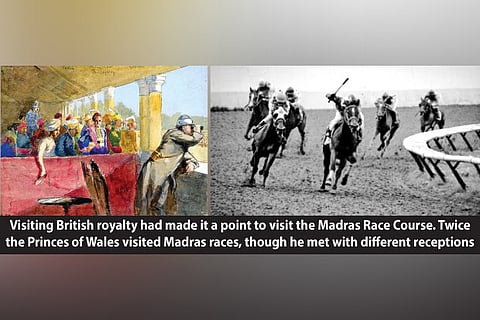

Chennai
It was 1777 and George Washington was fighting pitched battles across America to establish its independence and the Mughals were ruling Delhi when horses started racing for the pleasure of men in Madras, ahead of anywhere else in the subcontinent.
Mankind has always been fascinated with horses and the sight of a few horses racing with each other and their manes flying in the wind sent men into ecstasy.
Horse racing is one of the most age-old of all sports and has been practised in civilisations across the world since ancient times. But soon its basic premise became placing bets on the fastest horse.
Starting in the island in the Cooum because of safety and convenience to the fort residents next door, the Guindy spot, almost on the Adyar river, was chosen for equine racing soon enough. People may be surprised that the crowded city still has one of the biggest urban racecourses in the world but that was because the city grew beyond it. But when it was formed, the racecourse was surrounded by paddy fields and battlefields. Luckily, even today, it remains one of the largest lung spaces of the city, which has grown beyond it.
An entire village of Venkatapuram next to the Guindy forest and adjacent land from Velachery village — 81 cawnies in total — were allotted by the Chengalpattu Governor to conduct horse races. Racing in the initial years began at dawn and ended by 10 am so that people could get to work.
Fifty years later, as it became safer, with the invasion threat from Mysore receding, families were brought here to relax in an adjoining club, which was formed then and is still functioning in addition as a social club. It is recorded in East India Company records that “the entertainment took place in the cool season when the ladies of the settlement are invited to a splendid ball.”
The Assembly rooms built adjoining the Race Course were a landmark of the city. The buildings were knocked off in the 1990s and all we have remaining are a painting by William and Thomas Daniell done in 1792. The Guindy Lodge, built initially for the club secretary, and now a part of the Madras Race Club, came up in 1931.
During the trigonometric survey, William Lambton, a lieutenant colonel under Arthur Wellesley, who began a survey to map the entire British territory, used the Madras racecourse as his “baseline”.
Racing was close to the heart of the British and when suburban trains were planned even train routes were altered to not disturb the activity or scare the horses. When Stevenson, the proprietor of the Madras Photographic Store in what was literally the first cinema show in Madras in 1896 at the Victoria Public Hall showed many magic lantern slides, many of which were of the Guindy horse races.
Soon, the British let the Indians in and the zamindars and petty kings of the south considered the race club almost like a second home. In 1920, a stand was constructed with funds provided by two patrons, Maharaja of Bobbili and Maharaja of Venkatagiri but more than races it became a place of social interaction for that class. The romances bloomed, marriages were fixed and disputes solved. Weightier kings like the Baroda Gaekwad came for the racing seasons. In fact, the controversial marriage of the Baroda king with a married girl from Madras, Sita Devi, had hogged the headlines then.
Visiting British royalty too had made it a point to visit the course. Twice the Princes of Wales visited Madras races, though he met with different receptions. While the first one in 1875 was welcomed wholeheartedly, the second in 1921 faced a boycott by Congress. In fact, the government had to stock the race club stands with Guides and Scouts to give a semblance of full capacity.
The club came to be dominated by the mercantile community of Chettiars, who as horse owners and executive members of the club, controlled racing for nearly 75 years. The family of Rajah Annamalai Chettiar, especially his son MA Chidambaram and his grandson MAM Ramaswamy ran the show for most of the post-Independence years.
Chidambaram’s initiative was to introduce classic races in Madras in the 1950s. In 1953, he united five race clubs of South India and formed the Southern India Turf Club. On the other hand, MAM’s horses won up to 400 classic races.
Racing in Madras has been stopped due to several reasons: Invasion by Hyder Ali, World War I, and even financial instability. But the biggest threat came in 1974. Considered one of the biggest vices of the city, fortunes were lost and penury stared at the face of the betters in the racecourse. The Karunanidhi government, through an ordinance, banned racing, claiming that gambling can wreck families. In pride of its good Samaritan deed, the government installed two equestrian statues on Mount Road, which still remain, though the courts upturned the law and let the horses gallop and patrons gamble away.
—The author is a historian
Visit news.dtnext.in to explore our interactive epaper!
Download the DT Next app for more exciting features!
Click here for iOS
Click here for Android